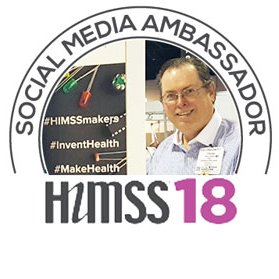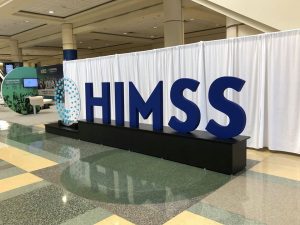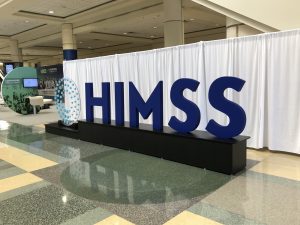You’re registered for HIMSS 2018 and your flight to Vegas and hotel room are booked. Nothing left but the waiting, right?
Well, not exactly. If you’ve never been to an annual gathering of the Healthcare Information and Management Systems Society (HIMSS), you may not realize just how different it is from your average health IT conference. To get the most from your experience at HIMSS18, from March 5 to 9 in Las Vegas, take a strategic approach to finding what you want to see, who you want to talk to and how you want to spend your time.
Take it from a HIMSS veteran.
Chuck Webster is a well-known face around HIMSS conventions. The Columbus, Ohio-based healthcare workflow expert has attended since the mid-1990s, seeing it grow from a few thousand people to what it is today.
“It’s like a giant city that comes into existence for four to five days,” said Webster, whose HIMSS “Maker Space” booth features 3D printers and DIY-style projects for attendees to try.
“First thing I do when I move to a new city is read up about it, then divide it into quadrants and go to all these places. Go over and scout this and that out, so in the beginning you’re just getting the big picture, and then go back and see the things that really caught your eye.”
With attendance now topping 40,000, it’s an understatement to say the conference is a good networking opportunity. But how do you make meaningful connections with so much to see and so many people to meet?
Think social networks.
“When I first started going, you’d bump into people and pick up your conversation where you left off the previous year,” Webster said. “As it got bigger and bigger, you bump into familiar faces less. Now I’m a firm believer in the social media aspect of networking at HIMSS.
“Around 2011 I started getting more involved with Twitter and having conversations with people on there. There would be meetups called Tweetups where you’d meet people in the flesh. By then you already have a rapport. It’s a lot easier going into a room where you’ve been having stimulating conversations with the people in it rather going into one where you don’t know anyone.”
Twitter is especially advantageous because users can “really think about what you want to say and put it out there strategically,” he said, describing HIMSS as an “opportunity to leverage your social media discussions, just on steroids.”
Webster recommends putting your Twitter handle in the space where your name would normally go – the most prominent spot on the badge.
“People will see your Twitter handle in big font. They may not know your name, but if they know you from Twitter, they’ll recognize you. Instead of mine saying Chuck, people will say, ‘Hey, there’s @wareflo!’”
The Social Media Ambassador
Webster is one of 20 or so social media ambassadors at HIMSS, a group picked not only for the size of their social networks, but for their depth of expertise in specific areas such as workflow, interoperability or patient engagement.
“Look at the list of social media ambassadors and their last 100 tweets,” Webster advises conference attendees. “Find who is addressing the stuff you’re interested in and start having conversations with them. They’re always looking for grist for the mill so to speak. It doesn’t matter how many followers you have or they have.”
Did you know? USF Health Online will be at HIMSS 18 on University Row! Follow us on Facebook, Twitter, LinkedIn and Instagram to stay tuned with what we’re doing at HIMSS 18!
After attaining his undergraduate degree in accounting with an emphasis in cost accounting and management information systems, Webster found his coursework intersecting with industrial engineering, another interest of his.
“Industrial engineering is a lot like financial engineering. It’s all about logistics and optimizing flows. I was going to get my PhD in health systems engineering and, because I had actually started out in accounting then done industrial engineering, I’d already taken all the necessary courses to go to medical school.”
He took the MCAT exam on a whim and was accepted to the University of Chicago’s medical school.
There, he was steered toward informatics.
“I met some people that were doing medical informatics, artificial intelligence, natural language processing and computational linguistics in Pittsburgh. I did a clerkship out there and ended up getting a master’s in artificial intelligence (MS in Intelligent Systems).”
He would go on to become a professor of medical informatics before leaving higher ed for the private sector, where as a software architect he designed medical records prototypes. Eventually, he took a position as chief medical informatics officer for an electronic health records (EHR) vendor in Atlanta.
“They were unusual because they were one of the few EHRs that was actually built on a workflow management system,” Webster said. “As an industrial engineer who deals with workflow and workflow technology, I looked at their systems and thought that’s very different from everybody else.”
The ‘Workflow Bear’
Webster describes himself as somewhat of a workflow evangelist during his decade in Atlanta.
“On one hand, I wrote code, on the other, I was an MD and wanted to give presentations and to educate. And you had to give a lot of presentations about workflow to get people to understand the difference between process-aware systems and workflow-oblivious systems. There’s a big difference between software that actually represents and models workflow and software that doesn’t. A lot of health IT software today is of the workflow-oblivious nature and that causes tremendous frustration.”
Eventually, Webster became a consultant and started his own blog, wareflo.com, where he continues to preach his passion.
“I became the ‘workflow bear,’” he said. “People mention workflow and it’s like poking a bear with a stick, out I come roaring. I can be very predictable in terms of saying the same thing over and over about workflow. I consult with people who are trying to productize their workflow systems in healthcare, people trying to take their health IT systems and make them work better from a workflow point of view.”
These days, he sees himself as a “Chief Medical Informatics Marketing Officer or CMIMO.”
“I’m selling medical informatics and workflow informatics to the point I’m like a cartoon character. I’m willing to be silly in order to attract people to the cause of workflow.”



